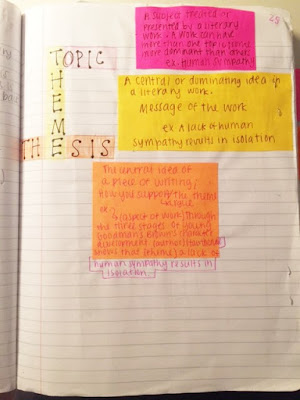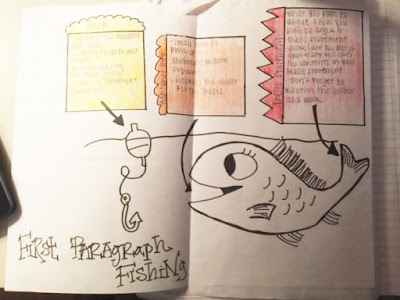Interactive notebooks seriously saved my life. After my first year teaching, I knew that I needed a better system. My children were learning, yet they weren't able to track their own growth AND I was getting frustrated when I had to repeat myself a million times. I tried a portfolio system for a while, but I didn't love it. My students were doing the assignment just to get it completed...they weren't seriously able to reflect on how much they had really learned.
I knew a couple of teachers who used notebooking in their Science, History, and Psychology classes, but never really any English teachers at my school who took the plunge. I spent my summer researching everything from elementary blogs, to secondary academic journals to find just the right formula for success. At this point in my teacher life, I COULD NOT IMAGINE NOT USING NOTEBOOKS! When I look back on things now I think, "How in the world did I ever keep a record of learning without a notebook!?" My notebook is my child - I can't imagine life before it. :)
My first year notebooking was a MESS. Here's a whole list of the scary, terrible, reasons (
1. I did not have a system for absent students - many students fell behind, then gave up.
2. I spent wayyyy too much $$$ on supplies - seriously, how hard is it to recap a glue stick, people!?
3. I didn't keep a notebook of my own, so when students had questions or accidentally skipped a page, I couldn't get them back on track.
4. The trash - no explanation needed.
5. Not everyone could afford a notebook of their own.
6. And the list goes on and on...
HOWEVER, after many failures, I finally learned ways to tweak the process and "fix" many errors. At this point in my teaching life, I have no idea how anyone could ever teach a class without interactive notebooks. Ya'll, I cannot say enough wonderful things about how note booking has changed my entire educational philosophy.
Here's why it works:
- The kids are engaged because they're doing something, literally. That's it. They are using their hands. They are having to pay attention because they are cutting out specific things and precisely gluing them.
- Also, they have an exact record of their learning. They can physically see each unit, step-by-step. They can also track their progress! All directions are printed right in their notebooks - no more questions about directions!
- Finally, one of the best reasons to utilize this "tool" is FOR PARENT CONFERENCES!!!! Parents LOVE seeing how their child has progressed through your class, AND it's also good for those parents who question what their child is or is not doing in class.
Over the past few years I've been asked many questions by other teachers at my school about my notebooks and I've heard my fair share of comments from people outside of my own little 300 hall. :) I've compiled a list of the top questions and comments I get and how I try to answer honestly AND show that these notebooks will change your teacher life for the better!
1. "So, are you just coloring with your kids?" I get so frustrated when I hear this. NO! Interactive notebooking is NOT a synonym for coloring. Yes, we UTILIZE coloring to stay organized, make things pop off the page, and trigger memory recall.
At the very beginning of the semester, I teach my children how to "Read Like a Pirate" and uncover hidden treasure in the text. We create a colorful foldable so that they understand how to highlight/underline different things in the text. Color coding REALLY helps them learn how to analyze a complex text. Here's an example:


2. "I don't have time for that."/"You must not have kids."/"Just wait until you get married/have kids" etc. Work is work, ya'll. It's what we make it! I can't imagine not being interested in the newest educational trends. I can't imagine not wanting my students to have a positive, almost entertaining classroom experience! The honest answer is, YES, it's A LOT of work. BUT, IT IS TOTALLY WORTH IT! I have VERY few behavior issues in my class. My motto is, if the kids are engaged, behavior will not be a problem. Notebook is not easy. It is rigorous and really challenges students. They have to pay attention, be organized, be independent, and stay on top of the material. My greatest challenges come within the first two weeks of every semester. I always have children who think they know better work ahead and cut a piece before I give instructions. This always ends in disaster. They truly have to figure out how to listen to me, my instructions, and focus on the material at the same time.
3. This sounds like such a distraction, does it not waste time? One of the main reasons why I love notebooking is that it actually gives the children a constructive break. 99% of the time my students are SILENT as they cut and glue. My school has 90 minute class periods, so sometimes they are hit with A LOT of information in just one class. Taking small breaks to cut and glue actually gives their brain a minute to absorb what they've just heard/seen. This is a great time for me to walk around and talk with them about what they've just learned, too. One-on-one time is so hard to get in the secondary classroom. These cut and glue breaks give me time to speak to 1-3 students and really focus on those that sometimes get overlooked. Andddd it's not like we're cutting just to cut or gluing just to glue! We're making things that stream line learning, like this:
I remember the moment that I knew these notebooks worked: A student approached me while taking a quiz and asked a question I couldn't answer without giving her the answer to the quiz. However, I told her, "We did a pink foldable on that. We even colored certain sections of the robot on the front." She instantly remembered and went back to her desk to ANSWER EVERY QUESTION CORRECTLY!
4. I can't stand the mess. I feel like my room will be wrecked by all of the paper or trash on the floor. I am probably the most panicked person in the world when it comes to my room being a wreck. If there's a pencil on the floor I CANNOT HANDLE IT. It typically takes less than a week for my students to learn to pick up after themselves. My students who finish early learn to walk around with the recycling bin and collect the trash from the other groups. At the end of the class, I always stop about 2 minutes early and play a game called, "Let's all pick up three pieces of trash." haha! I figure three pieces of trash multiplied by 30 students will really get the job done quickly. I promise you that all it takes is modeling tidy behavior for about a week. I used to walk around with trash cans and recycling bins and now the kids do it for me. They have a job, and I have a clean classroom.
5. I can't stand them getting up and getting materials constantly. It's too much back-and-fourth. I HAVE FOUND THE SOLUTION THIS YEAR! I purchased small crates from Target before school started. I keep my desks in "pods" for multiple different reasons: "team" points, group work, collaborative learning, AND ORGANIZATION OF MATERIALS! I paid about $3 for each crate, and it is TOTALLY WORTH IT. I also invested in a plastic tub for each crate to house the small supplies that might fall through the cracks. Beside each "pod" of desks, I sit the crate. I keep it full of materials that they'll need: scissors, rulers, glue sponges, highlighters, crayons, markers, colored pencils, a stapler, etc. Here is the end result:
The students don't ever have to leave their seats to get any supplies. Also, if you're tired of buying glue sticks, you need to make yourself some glue sponges! They seriously work. Mine have been going strong for 18 weeks now! Here's the tutorial!
Overall, YES notebooking is a lot of work. I spend a good week in the summer knocking out the prep work chunk. It's SO MUCH easier to continue for the rest of the year once you've got the skeleton of the notebook decided.
Also, some teachers stress over "teacher side = left side, reflection side = right side." I found that system to be ineffective. The kids forget what to write on which side, become frustrated, and give up halfway through your lesson. I do ask for my children to number each page and keep an updated table of contents for easy review. I plan on doing a blog post later in the year for how to set up the notebook: THE SCARIEST (but best) part!
The bottom line is you have to find what works best FOR YOU. I've done a lot of tweaking and changing my notebooks over the years. I still reflect on my work and change things from semester to semester. Being a perfectionist isn't easy ya'll! ;) I'd love to hear any tips or tricks that you have for interactive notebooking. Do ya'll get asked the same questions and hear the same thing that I'm getting? Let me know how you rock your notebooks in your own classroom!









No comments:
Post a Comment